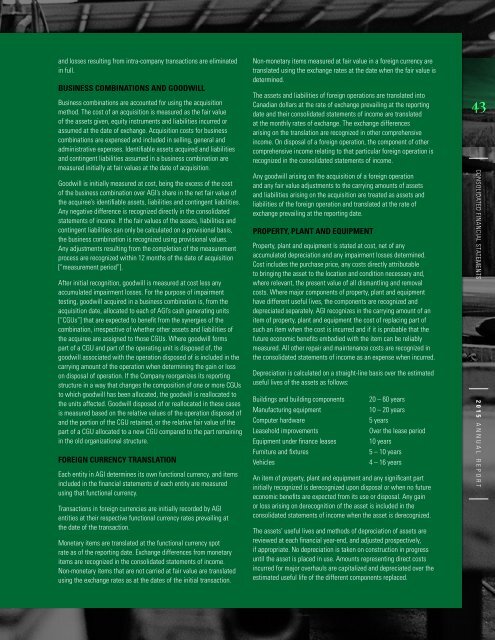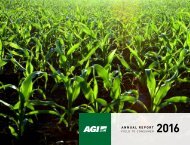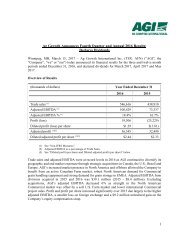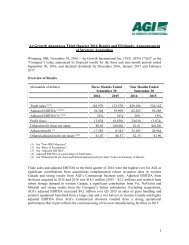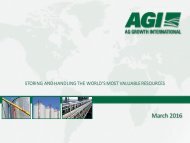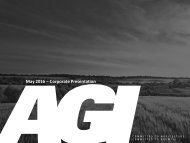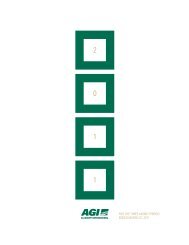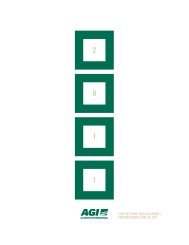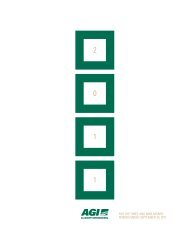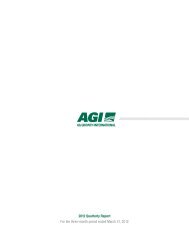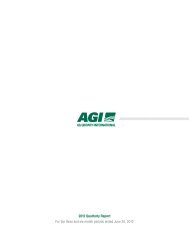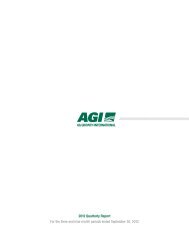Annual Report 2015
You also want an ePaper? Increase the reach of your titles
YUMPU automatically turns print PDFs into web optimized ePapers that Google loves.
and losses resulting from intra-company transactions are eliminated<br />
in full.<br />
Business combinations and goodwill<br />
Business combinations are accounted for using the acquisition<br />
method. The cost of an acquisition is measured as the fair value<br />
of the assets given, equity instruments and liabilities incurred or<br />
assumed at the date of exchange. Acquisition costs for business<br />
combinations are expensed and included in selling, general and<br />
administrative expenses. Identifiable assets acquired and liabilities<br />
and contingent liabilities assumed in a business combination are<br />
measured initially at fair values at the date of acquisition.<br />
Goodwill is initially measured at cost, being the excess of the cost<br />
of the business combination over AGI’s share in the net fair value of<br />
the acquiree’s identifiable assets, liabilities and contingent liabilities.<br />
Any negative difference is recognized directly in the consolidated<br />
statements of income. If the fair values of the assets, liabilities and<br />
contingent liabilities can only be calculated on a provisional basis,<br />
the business combination is recognized using provisional values.<br />
Any adjustments resulting from the completion of the measurement<br />
process are recognized within 12 months of the date of acquisition<br />
[“measurement period”].<br />
After initial recognition, goodwill is measured at cost less any<br />
accumulated impairment losses. For the purpose of impairment<br />
testing, goodwill acquired in a business combination is, from the<br />
acquisition date, allocated to each of AGI’s cash generating units<br />
[“CGUs”] that are expected to benefit from the synergies of the<br />
combination, irrespective of whether other assets and liabilities of<br />
the acquiree are assigned to those CGUs. Where goodwill forms<br />
part of a CGU and part of the operating unit is disposed of, the<br />
goodwill associated with the operation disposed of is included in the<br />
carrying amount of the operation when determining the gain or loss<br />
on disposal of operation. If the Company reorganizes its reporting<br />
structure in a way that changes the composition of one or more CGUs<br />
to which goodwill has been allocated, the goodwill is reallocated to<br />
the units affected. Goodwill disposed of or reallocated in these cases<br />
is measured based on the relative values of the operation disposed of<br />
and the portion of the CGU retained, or the relative fair value of the<br />
part of a CGU allocated to a new CGU compared to the part remaining<br />
in the old organizational structure.<br />
Foreign Currency Translation<br />
Each entity in AGI determines its own functional currency, and items<br />
included in the financial statements of each entity are measured<br />
using that functional currency.<br />
Transactions in foreign currencies are initially recorded by AGI<br />
entities at their respective functional currency rates prevailing at<br />
the date of the transaction.<br />
Monetary items are translated at the functional currency spot<br />
rate as of the reporting date. Exchange differences from monetary<br />
items are recognized in the consolidated statements of income.<br />
Non-monetary items that are not carried at fair value are translated<br />
using the exchange rates as at the dates of the initial transaction.<br />
Non-monetary items measured at fair value in a foreign currency are<br />
translated using the exchange rates at the date when the fair value is<br />
determined.<br />
The assets and liabilities of foreign operations are translated into<br />
Canadian dollars at the rate of exchange prevailing at the reporting<br />
date and their consolidated statements of income are translated<br />
at the monthly rates of exchange. The exchange differences<br />
arising on the translation are recognized in other comprehensive<br />
income. On disposal of a foreign operation, the component of other<br />
comprehensive income relating to that particular foreign operation is<br />
recognized in the consolidated statements of income.<br />
Any goodwill arising on the acquisition of a foreign operation<br />
and any fair value adjustments to the carrying amounts of assets<br />
and liabilities arising on the acquisition are treated as assets and<br />
liabilities of the foreign operation and translated at the rate of<br />
exchange prevailing at the reporting date.<br />
Property, plant and equipment<br />
Property, plant and equipment is stated at cost, net of any<br />
accumulated depreciation and any impairment losses determined.<br />
Cost includes the purchase price, any costs directly attributable<br />
to bringing the asset to the location and condition necessary and,<br />
where relevant, the present value of all dismantling and removal<br />
costs. Where major components of property, plant and equipment<br />
have different useful lives, the components are recognized and<br />
depreciated separately. AGI recognizes in the carrying amount of an<br />
item of property, plant and equipment the cost of replacing part of<br />
such an item when the cost is incurred and if it is probable that the<br />
future economic benefits embodied with the item can be reliably<br />
measured. All other repair and maintenance costs are recognized in<br />
the consolidated statements of income as an expense when incurred.<br />
Depreciation is calculated on a straight-line basis over the estimated<br />
useful lives of the assets as follows:<br />
Buildings and building components<br />
Manufacturing equipment<br />
Computer hardware<br />
Leasehold improvements<br />
Equipment under finance leases<br />
Furniture and fixtures<br />
Vehicles<br />
20 – 60 years<br />
10 – 20 years<br />
5 years<br />
Over the lease period<br />
10 years<br />
5 – 10 years<br />
4 – 16 years<br />
An item of property, plant and equipment and any significant part<br />
initially recognized is derecognized upon disposal or when no future<br />
economic benefits are expected from its use or disposal. Any gain<br />
or loss arising on derecognition of the asset is included in the<br />
consolidated statements of income when the asset is derecognized.<br />
The assets’ useful lives and methods of depreciation of assets are<br />
reviewed at each financial year-end, and adjusted prospectively,<br />
if appropriate. No depreciation is taken on construction in progress<br />
until the asset is placed in use. Amounts representing direct costs<br />
incurred for major overhauls are capitalized and depreciated over the<br />
estimated useful life of the different components replaced.<br />
43<br />
CONSOLIDATED FINANCIAL STATEMENTS <strong>2015</strong> ANNUAL REPORT


